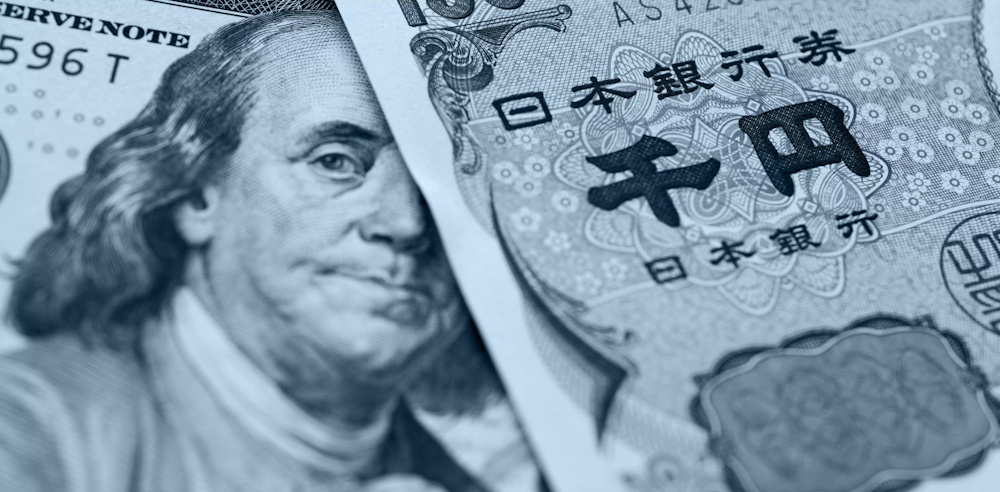USD/JPY recovered above 153.00 following a 100-pip, 0.68% decline, as buyers supported the 20-day setup amidst a more stable U.S. rates environment. Spot regained 153.00 as U.S. 10-year Treasuries stabilized around ~4.6%, reinforcing the established correlation between the two and front-end U.S. yields. The immediate map is clear: initial support is located around 153.00, with a weaker level at 152.80; a drop below 152.80 would draw attention to the 20-day SMA near 152.52, while the pivot from October 29 at 151.53 represents a significant threshold that could indicate a shift in trend if breached. Topsides are equally clean: 154.00 marks the November 4 peak at 154.48; above it, the psychological 155.00 is next, with 156.50 as the stretch level if momentum re-accelerates. The rolling correlation between USD/JPY and Fed cut pricing has been notably high, exhibiting a strongly negative coefficient. As deeper cuts for 2026 are priced in, the pair tends to decline; conversely, fewer cuts and a firmer near-term policy stance support the dollar. Given the reduced U.S. data calendar due to the shutdown, the significance of speeches and Treasury supply has increased considerably. The week features auctions for 3s, 10s, and 30s; robust demand that drives yields lower typically exerts downward pressure on USD/JPY, whereas a weak bid-to-cover that reduces the curve leans back toward the 154–155 range. The risk appetite continues to serve as a secondary factor: equities experienced fluctuations, yet the carry bid persists, ensuring that dips remain shallow as long as U.S.–Japan short-rate spreads do not compress significantly.
Tokyo’s 30-year JGB auction serves as a volatility wildcard; a lack of demand that reduces prices at the super-long end can impact overall term-premium dynamics, sometimes resulting in an increase in USD/JPY through yield differentials. The upcoming PPI later this week provides insights into pipeline pressures that may influence the BOJ’s stance on gradual normalization discussions. Communication from BOJ board members has been limited; any unexpected hawkish nuances—regarding inflation persistence, wage dynamics, or indications on balance-sheet adjustments—could alleviate upward pressure on USD/JPY. Prime Minister Takaichi’s growth-first fiscal stance advocates for a patient approach at the BOJ, yet it heightens concerns regarding foreign exchange optics if depreciation appears chaotic. Market micro tells suggest that interventions focus on speed and disorder rather than on round numbers. The most recent clean episode reached above 160, coinciding with increased spot volatility. Today, the spot surged back to approximately 153–154 amidst a significantly calmer market environment.
Discussions around policy suggest a tolerance level reaching 158, and potentially extending to 160 in the event of a chaotic overshoot, particularly if there is a surge in speculative positioning and options volatility. Political calculus is crucial: domestic assets are not showing signs of stress, public concern regarding the weak yen is not pressing, and reserves are already allocated for strategic commitments overseas—continued yen-buying would entail an opportunity cost. For traders, the implications are clear: interventions represent a tail risk beneath 158, a live risk within the 158–160 range, and a base case scenario solely during a rapid, volatile spike. Momentum indicators showed improvement with the reclaim of 153.00; the RSI shifted back to a neutral-positive stance on intraday charts, while the daily MACD continues to exert enough weight to maintain rallies in check below 154.50. The market is adhering to its structural levels: 153.00 serves as the intraday pivot, 154.00/154.48 acts as the ceiling, and 155.00 is identified as the headline risk zone. A daily close above 154.48 indicates a measured advance towards 155.00, where options gamma typically limits further movement unless there is a new yield catalyst. Failures back through 152.80 generally test the 20-day at approximately 152.52; if that level is lost on a closing basis, the route to 151.53 expands, leading to a more substantial long liquidation.
Implied volatility has fluctuated within a narrow range—one-month tenor fell below 8% earlier in the week, then increased toward approximately 11% as market participants adjusted for event risk related to auctions, Federal Reserve speakers, and supply from Japan. The skew continues to reflect intervention awareness: downside yen calls are becoming more valuable in the 158–160 scenarios, while the near-term topside remains profitable but is limited by official risk. Strategically, implementing bull call structures aimed at the 154.50–155.00 range is advisable when trading above 153.00, particularly in a stable to rising U.S. yield environment; conversely, below 152.80, put spreads to 151.50 present advantageous convexity. For volatility traders, short-dated straddles remain effective when initiated near 153.00, provided that tight risk controls are in place. Micro-catalysts surrounding auctions frequently disrupt the intraday range, even within a low-IV environment. The resilience of the Nikkei and the decline in super-long JGB yields lessen the need for yen-supportive measures. Meanwhile, a slightly weaker Dollar Index during the day did not hinder USD/JPY from bouncing back, highlighting that rate spreads specific to the pair are the primary influence on market movements.
The softness in energy and the more stable credit spreads have not diminished the carry impulse. As we approach Veterans Day, the reduced liquidity in U.S. cash Treasuries may amplify market movements; it is advisable to capitalize on this by fading extremes at the specified levels instead of pursuing mid-range declines. Above 153.00, the strategy favors buying on dips, with a break at 154.00 serving as the initial trigger and 154.48 providing confirmation; the target is set at 155.00, with a potential extension to 156.50 contingent upon an increase in U.S. 10-year yields and a reduction in front-end pricing for 2026 cuts. Should the price drop below 152.80, the outlook shifts to neutral-to-bearish, targeting 152.52 and 151.53, unless there is a rapid recovery above 153.20. Headline risk increases significantly with any Ministry of Finance commentary above 155, and even more so as it approaches 158. In those ranges, consider reducing gross long positions in USD/JPY, substituting with optionality, or implementing collars to mitigate gap-risk.

